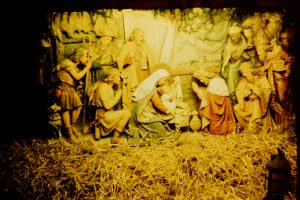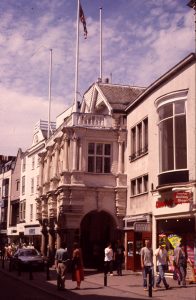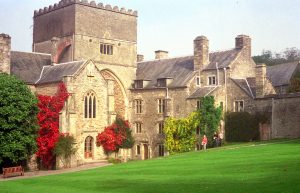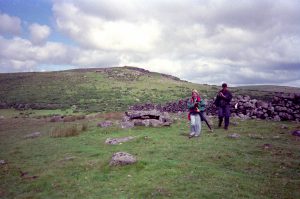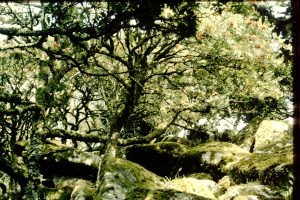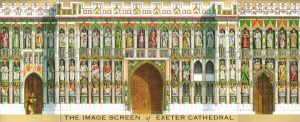 The image screen on the west front of Exeter Cathedral is one of its medieval treasures. It contains three registers of deep-relief stone carvings of angels, kings and knights, apostles and prophets. The lowest register is a horizontal row of 25 demi-angels or half angels, carved from the waist upward. All the figures are carved in local limestone brought from Beer in Devon in 1342 to 1348. Beer stone is wonderful for the carver, in this case a man named William Joy, but the limestone has not held up well to the elements encountered on the west front of the cathedral over nearly seven centuries. A few of the angels have been replaced but many details of the figures are badly eroded away in most cases.
The image screen on the west front of Exeter Cathedral is one of its medieval treasures. It contains three registers of deep-relief stone carvings of angels, kings and knights, apostles and prophets. The lowest register is a horizontal row of 25 demi-angels or half angels, carved from the waist upward. All the figures are carved in local limestone brought from Beer in Devon in 1342 to 1348. Beer stone is wonderful for the carver, in this case a man named William Joy, but the limestone has not held up well to the elements encountered on the west front of the cathedral over nearly seven centuries. A few of the angels have been replaced but many details of the figures are badly eroded away in most cases.
The second register was carved between the 1340’s and 1380, the year in which my story, Plague of a Green Man, is set. William Joy’s original plan also had niches for 25 statues in this register. Ten statues in this row date to the 1340’s. They include eight kings and two knights as well as two demi-kings. Many of the kings are seated. Work on this register stopped with the arrival of the Black Death in 1348 and then resumed in the 1370’s, perhaps by a man named John Pratt. Seven of his statues survive to the present. In general, these statues in the second register have fared much better than those in the register below.
The first two registers formed the image screen that my heroine, Lady Apollonia, would have encountered when she visited Exeter Cathedral in 1380. Today we see bare stone, but in her time, each of the statues would have been brightly coloured, as shown in the reconstruction above. After viewing a colourful image as in the reconstruction, she walked around its north end to enter the cathedral through its, at that time, brand new north porch.
A third, upper register of Exeter’s image screen was added in the 1460’s, some 80 years after my heroine’s visit to the cathedral. It consists of 35 statues, many of which are apostles along with some prophets. A few statues have been replaced over the years, and all their colour has been worn away or removed. Still, by looking at the contemporary screen, we can get some sense of what my heroine would have seen at the time of her visit in the 14th century.
For more information on the Exeter Cathedral Image Screen, click on
http://demolition-exeter.blogspot.com/2013/05/exeter-cathedral-image-screen.html .

